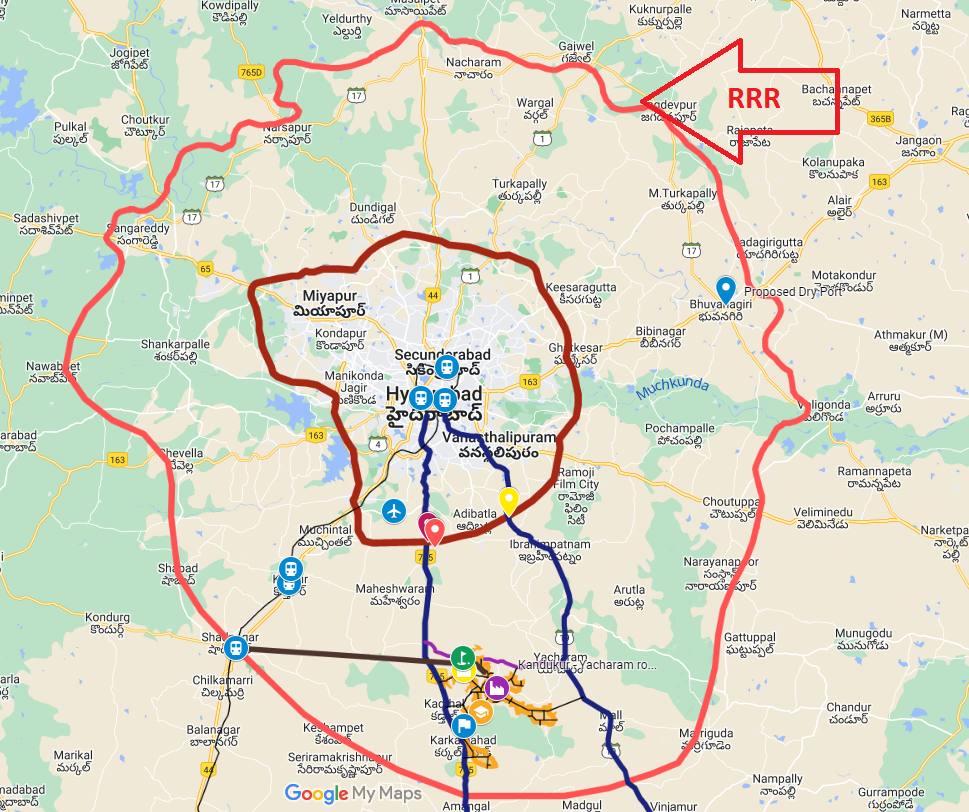The Regional Ring Road Hyderabad (RRR) is a proposed expressway that will encircle the city of Hyderabad, the capital of Telangana state in India. The RRR project is aimed at decongesting the traffic in Hyderabad by providing an alternate route for vehicles that do not need to enter the city.
The proposed Regional Ring Road will be around 330 km long and will have six lanes. It will connect all the major highways around Hyderabad, including NH-65, NH-44, NH-161, and NH-765. The RRR will pass through six districts surrounding Hyderabad: Sangareddy, Medak, Yadadri, Rangareddy, Nalgonda, and Mahabubnagar.
The RRR project is being implemented by the Telangana government through the Hyderabad Metropolitan Development Authority (HMDA) and is expected to cost around Rs. 20,000 crore (approximately USD 2.7 billion). The project is expected to improve connectivity, reduce travel time, and boost economic growth in the region.

Here are a few more things about the Regional Ring Road (RRR) in Hyderabad:
- The RRR project was first proposed in 2015, and the Telangana government has been actively pursuing it since then. The project is part of the state government’s larger plan to develop a comprehensive transportation system for Hyderabad and the surrounding regions.
- The proposed route for the RRR passes through several environmentally sensitive areas, including the Kondapochamma Sagar reservoir and the Amrabad Tiger Reserve. The government has stated that it will take steps to minimize the environmental impact of the project, including building underpasses and flyovers to avoid disturbing wildlife habitats.
- The RRR is expected to have a significant impact on real estate prices in the areas it passes through. Property values are expected to increase as connectivity improves, and new commercial and residential developments are expected to be built along the RRR.
- The RRR project has faced some opposition from farmers and landowners whose land will be acquired for the project. The government has stated that it will provide compensation and rehabilitation to those affected by the project.
- The RRR project is expected to be completed in several phases, with the first phase covering around 158 km. The government has stated that it will fund the project through a combination of loans, grants, and public-private partnerships.
Benefits of Regional Ring Road (RRR) project in Hyderabad:
- The RRR project is expected to have a significant impact on transportation and logistics in the region. It will provide an alternate route for heavy vehicles traveling to and from major industrial hubs and ports, reducing congestion on the city’s roads and improving connectivity.
- The RRR is expected to boost economic growth in the region by promoting industrial development and attracting new investment. It will provide better connectivity to Special Economic Zones (SEZs), industrial parks, and logistics hubs in the region.
- The RRR project is part of a larger plan to develop a comprehensive transportation system for Hyderabad and the surrounding regions. The government is also investing in the development of metro rail, suburban rail, and bus rapid transit systems to improve connectivity within the city.
- The RRR project has been designed to incorporate several safety features, including service roads, pedestrian footpaths, and overpasses. The government has also stated that it will ensure proper maintenance and upkeep of the road to ensure safety for commuters.
- The RRR project is expected to take several years to complete, and the government has set a target completion date of 2025 for the first phase of the project. However, delays are possible due to various factors such as land acquisition, environmental clearances, and funding constraints.
